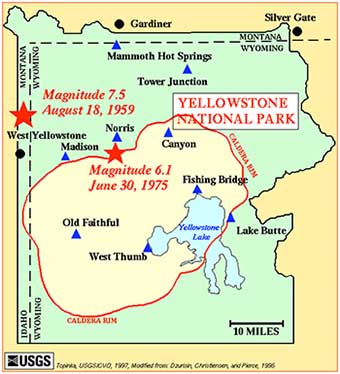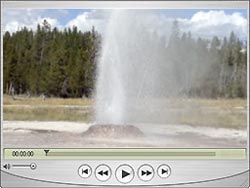Supervolcanoes and Flood Basalts
Some volcanic systems are vast plains or giant calderas that are often too big, too spread out, or too eroded for the untrained eye to see.
Supervolcanoes (also called calderas or megacalderas), such as the mammoth Yellowstone caldera, have a sunken crater that is so large and overrun with vegetation that visitors often have no idea that they’re standing on a volcano—let alone the most dangerous type of one. It takes a bird’s-eye view, some knowledge of geology, and far-ranging fieldwork to map out its shape.
|
Based on illustration from U.S. Geological Survey, Vancouver, Washington. The map of Yellowstone National Park outlines the caldera, with volcanic features including hot springs and geysers. |
|
Yellowstone National Park in Wyoming is famous for its many geysers. |
For example, Yellowstone has three ancient calderas filled with extraordinary volumes of ejected material from blasts that shook the world, the last one about 700,000 years ago. No supervolcanoes have erupted in modern history. Two of the most recent ones were in Lake Taupo, New Zealand (about 26,000 years ago), and Lake Toba, Indonesia (about 75,000 years ago). The explosion of a supervolcano would be roughly 100 times more powerful than Krakatau’s eruption.
Another type of hidden volcano does not even look like other volcanoes. Imagine a river that rises, overflows its banks, and quickly overwhelms a vast expanse of land. The same thing can happen with magma. All it takes is a very long crack for an opening, instead of a small, round vent, and lava that’s extremely runny, like basalt.
The aftermath of this type of eruption is a flood basalt, a dark expanse of lava rock stretching over land or ocean floor. Repeated eruptions create a lava plateau—thick, concentrated layers of lava rock.
Flood basalts are not always located near plate boundaries and might be associated with distant hot spots where the crack once stood. Two of the biggest lava plateaus on Earth are the Siberian Traps of Russia and the Deccan Traps of India. Trap comes from the Swedish for “stairs” and refers to the tiered face of a lava plateau that has eroded, exposing its layers.
 Photo courtesy of Geological Society of London. The Columbia River flood basalts are an example of a lava flow that occurs from a long crack rather than a vent in a mountain. The layers that result from this type of flow are visible in the rock outcrops.
|
 Photo courtesy of Anne-Lise Chenet/Institute de Physique du Globe de Paris. The Deccan Traps of India, seen in this outcrop in quarry near Pune, is one of the world’s largest lava flows, now covering 500,000 square km (193,051 square mi) |
All of these diverse volcanic systems stem from a vent and a source of magma. That fact raises the question: Where on Earth’s crust is the magma on tap?
This content has been re-published with permission from SEED. Copyright © 2024 Schlumberger Excellence in Education Development (SEED), Inc.



